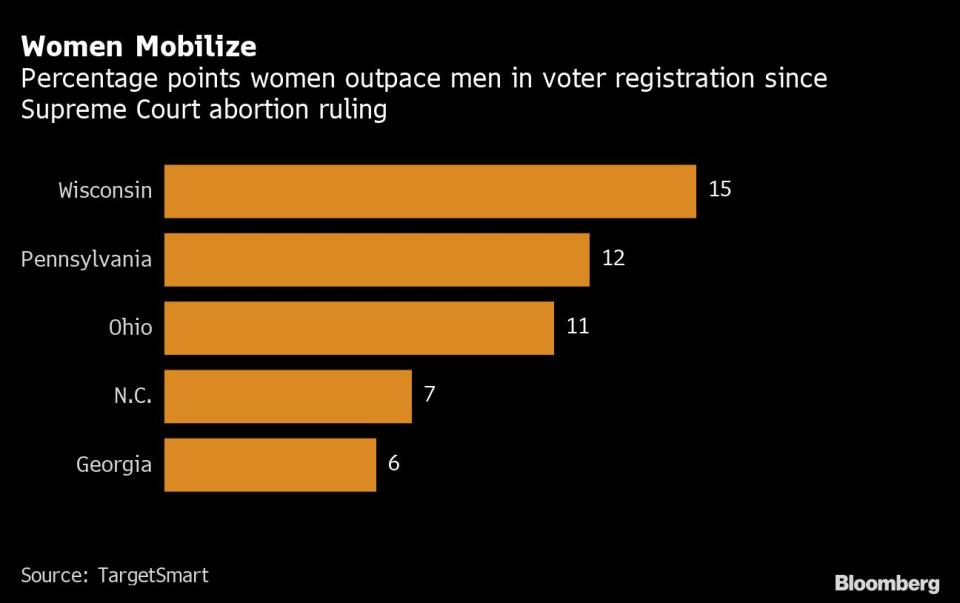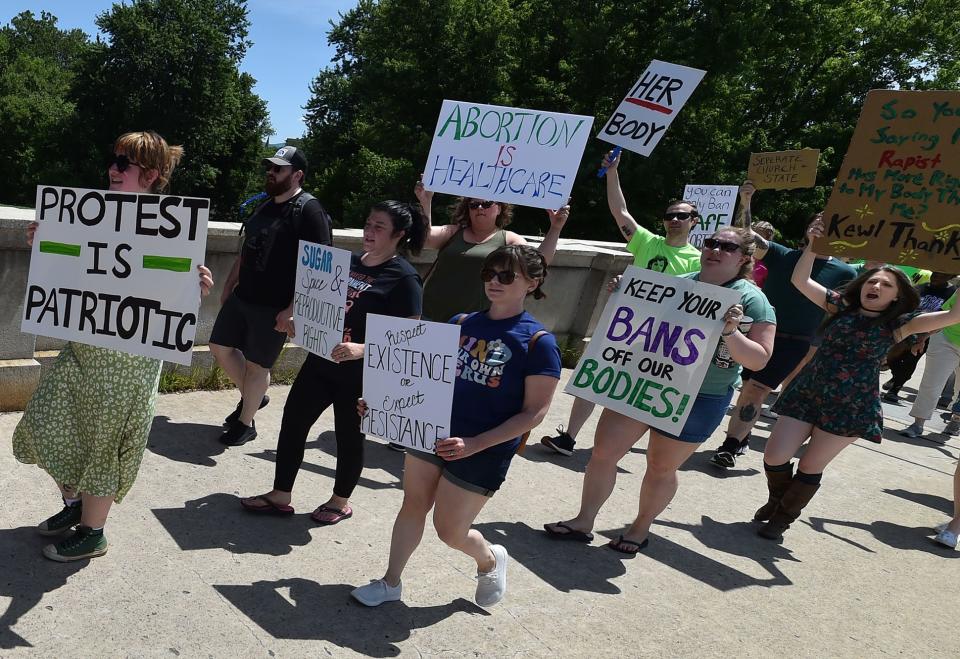Women’s Voter Sign-Ups Surge After Roe Ruling, Buoying Democrats
- Oops!Something went wrong.Please try again later.
(Bloomberg) -- The number of women signing up to vote has jumped in key midterm battleground states since the Supreme Court struck down a national right to abortion, with Democrats benefiting as the issue pushes to the forefront in campaigns.
Most Read from Bloomberg
Adani Becomes World’s Third Richest Trailing Only Musk, Bezos
There’s a New Recession Canary in the Coal Mine, Morgan Stanley Says
Mikhail Gorbachev, Soviet Leader Who Ended Cold War, Dies at 91
Elon Musk Attacks Twitter Deal Over Whistle-Blower as Feud Escalates
Women have outpaced men in new voter registrations by 11 percentage points in Ohio, 12 points in Pennsylvania and 15 points in Wisconsin since the court’s June 24 ruling. In Georgia, the margin was 6 points and in North Carolina 7 points.
The new voters are overwhelmingly young and Democratic, according to TargetSmart, a Democratic data analytics firm that compiled the numbers from state voter files. That could prove pivotal in the party’s battle with Republicans for control of the House and Senate. Women have been an essential part of the Democratic base in past midterms.
Among many pro-abortion rights women, particularly those of child-bearing age, “there is sense of direct threat to their lives, literally deciding for them and having a direct impact on their reproductive rights,” said Kelly Dittmar, research director for the Center for American Women and Politics at Rutgers University.
The registration figures are another sign of the real-world political impact of the high court’s decision overturning the 1973 Roe v. Wade ruling, potentially shifting the November election from a referendum on President Joe Biden’s performance in office to one about choosing sides on potent cultural issues.
Additional evidence includes the special election for a New York House seat last week that turned on the issue of abortion, the decisive defeat of an anti-abortion ballot measure in solidly Republican Kansas and polls showing Democrats pulling even with Republicans in voter preferences.
That’s a turnabout from earlier in the year when Republicans looked to be cruising toward a sweep in House and Senate races.
Other events also have contributed to the shift of attention away from the economy as a defining issue in the election. Those include a series of deadly mass shootings, House hearings on Donald Trump’s role in the Jan. 6, 2021 insurrection; and Trump’s headline-grabbing battle with the FBI over the agency’s seizure of classified materials from his Mar-a-Lago home.
The focus of voters may yet shift back to discontent over inflation and the economy. Republican campaigns will unleash millions of dollars in advertising as the election draws closer that will pound away at Biden on inflation and crime. The price of gasoline, which for more than a year had been the most visible sign of inflationary pain but as of Sunday was down 23% from the June 13 peak in the national average, could head back up, particularly if a September hurricane shuts down key refineries in the Gulf of Mexico.
For now, Democrats are making up ground. Democratic candidates have outperformed Biden’s 2020 vote share in all four special elections to fill vacant U.S. House seats since the Supreme Court ruling. In New York, Democrat Pat Ryan unexpectedly won an Aug. 23 House special election in a swing district in the Hudson Valley with a campaign focused on protecting abortion rights.
Democrats in early August pulled even in national polling averages on which party voters would prefer to see in charge of Congress for the first time since last November. And after lagging behind Republicans on voting enthusiasm most of the year, Democrats also have gained, with 66% of Democrats versus 68% of Republicans saying they have a “high interest” in voting this year, according to an NBC News poll taken Aug. 12-16.
Campaign Ads
Since July 1, nearly a quarter of all television advertisements broadcast by Democratic candidates have featured abortion rights while only 2% mention Biden. Among Republican candidates, the proportions are reversed: 22% include Biden by name but only 4% mention abortion, according to data compiled by AdImpact through Friday.
Republicans are still favored to win control of the House, benefiting from redistricting and historical trends favoring the opposition party in midterm elections. But analysts at the non-partisan Cook Political Report have scaled back forecasts of GOP gains from 15 to 30 seats to 10 to 20 seats.
However in the Senate, even Republican leader Mitch McConnell said his party’s chances of getting a majority are only a “fifty-fifty proposition.” Pennsylvania, Wisconsin, Georgia, North Carolina and Ohio are among the battlegrounds where that will be decided.
The court ruling “has taken an electorate that was decidedly more Republican and turned it into a more balanced electorate,” former Representative Tom Davis, who headed the campaign arm of House Republicans from 1999 to 2003, said. The November vote is “going to be a lot closer than a lot of Republicans anticipated.”
Populist Trump acolytes also dominated Republican primaries for high-profile competitive statewide gubernatorial and US Senate elections, with a few exceptions, heightening the focus on ideological differences.
The Trump Factor
“Trump has put himself back on the ballot through these extremist candidates,” said Sarah Longwell, an anti-Trump Republican strategist and publisher of the conservative website The Bulwark.
Longwell, who conducts voter focus groups on a weekly basis, said college-educated suburban women voters, a swing constituency she follows that leaned toward Biden in 2020, had been gravitating back to Republicans last year amid frustration over school coronavirus restrictions, crime and inflation but are now being repelled by the GOP again.
The surge in mostly Democratic-leaning women registering to vote has broader ramifications than mere numbers added to voter rolls. Not only are newly registered voters especially likely to cast ballots in the coming election but they are a telling gauge of a constituency’s mobilization, said Tom Bonier, TargetSmart’s chief executive officer.
“Registration trends can be a good indicator of intensity,” Bonier said. “If you see a group that is surging in registration, you should expect to see higher turnout from that group.”
Most Read from Bloomberg Businessweek
YouTube Went to War Against Terrorists, Just Not White Nationalists
The Secret Sauce at Hot Chicken Takeover: Its Unique Workforce
Chipmaking’s Next Big Thing Guzzles as Much Power as Entire Countries
©2022 Bloomberg L.P.



